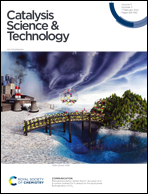Comprehensive study of the light-off performance and surface properties of engine-aged Pd-based three-way catalysts
Abstract
The light-off performance of engine-aged model three-way catalysts composed of a mixture of Pd/Al2O3 and Pd/CeO2–ZrO2 was evaluated by using a simulated exhaust gas and an engine dynamometer. A satisfactory correlation was observed between the light-off temperature for engine-aged catalysts evaluated under simulated- and real-exhaust gas conditions, suggesting that the elucidation of the catalytic behavior using powder catalysts under simulated exhaust gas conditions is coupled to understanding the phenomena that occurred on the catalysts under realistic conditions using the engine dynamometer. Hydrogen temperature programmed reduction (H2-TPR) measurements and Fourier-transform infrared (FTIR) spectroscopy following CO adsorption revealed that the quality of the Pd–support oxide interface as well as the surface state of Pd particles are strongly affected by high-temperature engine ageing. The Pd particle size dependence on the fraction of the Pd corner sites was consistent with that of the turnover frequency for NO reduction and CO/C3H6 oxidation, indicating that Pd particles with a high fraction of corner sites are highly active for three-way catalytic reactions.



 Please wait while we load your content...
Please wait while we load your content...